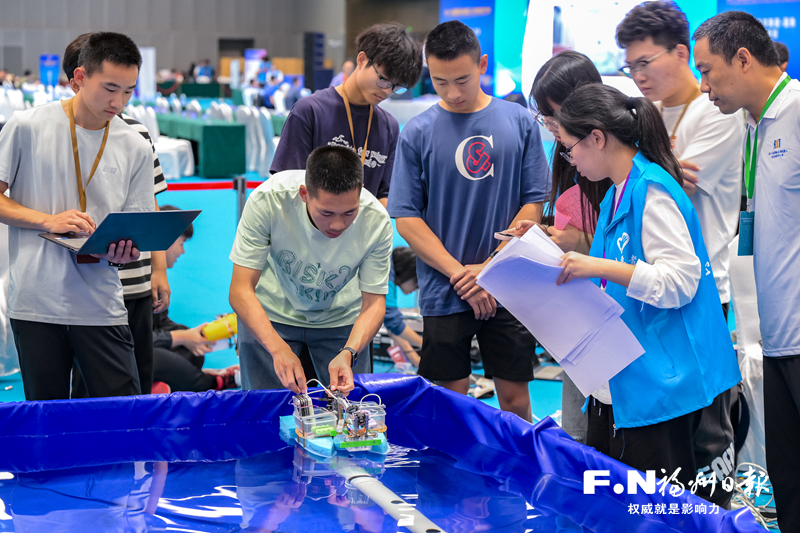Underwater Robots Competed in Fuzhou
350 teams and over 600 competitors from renowned domestic universities participated
Vivid biomimetic koi gracefully flick their tails underwater, a compact tethered underwater robot precisely retrieves target objects, and an autonomous underwater vehicle makes real-time judgments based on underwater conditions without human operation... As part of the series of activities during the World Maritime Equipment Conference 2024, the Smart Ocean Track National Final of the 17th International Advanced Robot and Simulation Technology Competition was held on November 16 at the Fuzhou Digital China Convention and Exhibition Center.
The competition featured nine categories: underwater control, engineering projects, autonomous vision, global vision, surface robots, biomimetic underwater robot innovation, underwater intelligent equipment innovative design, underwater robot simulation, and 3D digital design. At the scene, 350 teams and over 600 competitors from well-known domestic universities such as Peking University, Tsinghua University, Nankai University, Xiamen University, Fuzhou University, and Xi’an Jiaotong University showcased their underwater robots, bringing the future scenarios of underwater operations vividly to life.
“Compared to land and air environments, underwater robots must consider more environmental factors such as water flow, water pressure, and aquatic organisms. Ensuring the robot can accurately and stably grasp target objects in the complex underwater environment requires competitors to have advanced theoretical and practical abilities in areas such as signal transmission, control systems, and fluid dynamics,” said Yu Hong, secretary-general of the Robotics System Simulation Committee of the China Simulation Federation and responsible person of the competition. Looking in the direction Yu pointed out, at the underwater control group competition area, a large pool was surrounded by competitors observing the water conditions.

The participants used self-made equipment to take part in the oil pipeline inspection technology challenge. Reporter: Chen Nuan / Photography
Carefully checking the connection signals of the equipment, confirming the water level, and accurately locating target objects... Despite having participated in and won major awards in international competitions such as the MATE International Underwater Robotics Competition, Xin Shunheng from Xi’an Jiaotong University and his teammates remained cautious as they confirmed the robot’s status.
“I heard that this year’s competition added an underwater robot competition with a cable, and the underwater control scenarios are very rich. We are here for this,” Xin Shunheng told reporters. He and his teammates have been focusing on the development and manufacturing of cable-operated underwater robots and have organized six teams to specialize in the underwater control category. “We hope to continuously gain experience through the competition and push our robots toward commercialization and scaling.”
“I’m glad to see that the exhibits in the competition are getting ‘younger’, and people are paying more attention to the integration of new technologies and practical applications,” said Xie Guangming, the founder of the competition, director of the Robotics System Simulation Committee of the China Simulation Federation, and a professor at Peking University. “Learning for practical use is the essence of this competition.”
“Fuzhou has rich marine resources, developed fishery and aquaculture, and unique conditions for the research and application of underwater robots. We maintain friendly exchanges with Fuzhou University, and we believe that with more breakthroughs in underwater robotics, it will empower the local marine economy through underwater exploration, rescue operations, fishing vessel cleaning, and aquaculture,” Xie Guangming said.
This competition not only serves as a “touchstone” for students to test their learning outcomes but has also become a “treasure chest” for universities and research institutions to showcase their latest achievements.
At the booth of Xiamen University, a seemingly ordinary cylindrical object caught the attention of many people. “This is our latest development, a single-photon lidar, primarily used for underwater terrain and topography, as well as underwater oil spill remote sensing and other multi-scenario detection. It is the first of its kind in China to achieve breakthroughs in low energy consumption, miniaturization, and domestic production,” said Associate Professor Shangguan Mingjia from the College of Ocean and Earth Sciences, Xiamen University. In underwater exploration tasks, traditional lidars are limited by their size, energy consumption, and other factors, which restricts their application. However, the newly developed single-photon lidar, measuring 40 cm in length, is only 1/5 the size and 1/20 the energy consumption of traditional products in the same category. It can be mounted on drones, unmanned vessels, and underwater autonomous vehicles, greatly expanding its application scenarios.
“Currently, our products have been installed on several research vessels, including Xiamen University's ‘Jia Geng’ research ship. This competition is held alongside the World Maritime Equipment Conference 2024, and we hope to better showcase our products through this platform, working with more partners to promote the high-quality development of marine equipment,” said Shangguan Mingjia. (Reporters: Wu Huazhen / Text, Chen Nuan / Photography)







